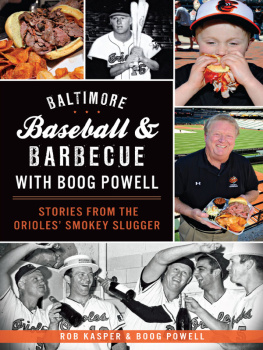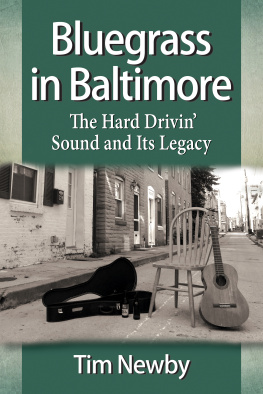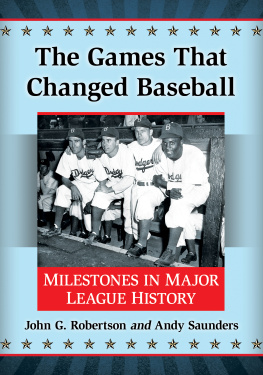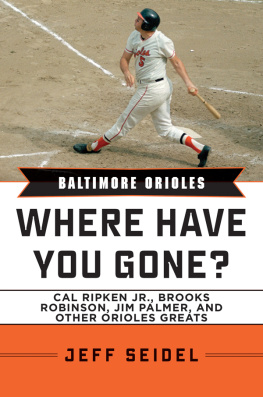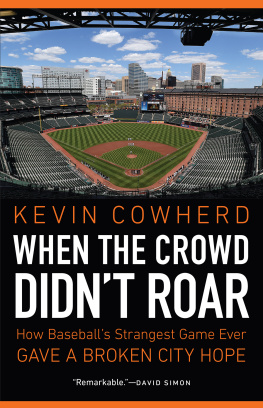
Published by American Palate
A Division of The History Press
Charleston, SC 29403
www.historypress.net
Copyright 2014 by Rob Kasper and Boog Powell
All rights reserved
First published 2014
e-book edition 2014
ISBN 978.1.62585.105.5
Library of Congress CIP data applied for.
print edition ISBN 978.1.62619.578.3
Notice: The information in this book is true and complete to the best of our knowledge. It is offered without guarantee on the part of the authors or The History Press. The authors and The History Press disclaim all liability in connection with the use of this book.
All rights reserved. No part of this book may be reproduced or transmitted in any form whatsoever without prior written permission from the publisher except in the case of brief quotations embodied in critical articles and reviews.
To Jan and the kids. They have put up with all my idiosyncrasies.
It has not been an easy life, and they adjusted to make it happen.
Boog Powell
CONTENTS
ACKNOWLEDGEMENTS
When writing the story of someones life, cooperation from his or her family is crucial. The Powell family has been most helpful in this project. Charlie and Richard Powell provided story after story about growing up with their brother, as did Carl Taylor, Boogs stepbrother and fellow major leaguer. Jean Terry, Boogs cousin, offered many details of the early life of the Powell boys in Lakeland and Key West.
Boogs son, J.W., and daughters, Jennifer and Jill, were forthcoming with tales about living with the man whom fans called Boog but they knew simply as dad. J.W. was also most helpful in plowing through files of family photographs in Key West, and Jan, Boogs wife, was adept at identifying the who, what and where attached to the old photographs.
Former Orioles teammates generously gave of their time to talk in interviews about their teammate. The Hall of Fame Robinsons, Brooks and Frank, offered long, warm and thoughtful recollections of playing with Boog, as did Jim Palmer, another Hall of Fame player. Andy Etchebarren, Merv Rettenmund and Eddie Fisher not only assessed Boogs baseball skills but also offered insights into his personality and his cooking.
Hugh Gallagher, the former ARA executive, told how he and Boog cooked up the idea of Boogs Camden Yards pit beef operation and how the concept spread to other ballparks throughout the nation.
Anyone who has visited Boog at his Camden Yards stand or his Key West home discovers that he has a large unofficial family. I met many of them. Thanks to Ann OBrien, Wayne Dougherty, Randy McNeese, Jim Halloran, Jack Hughes, Rod Rodriguez, Stan Charles, Jim Henneman and Bill Steka.
Much of the research for this book consisted of reading newspaper accounts of games gone by. The Baltimore County Library has an excellent online repository of Baltimore newspapers. Reading these accounts gave me a new appreciation of the daily work of former Sun and Evening Sun sportswriters such as Jim Elliott, Phil Jackman and Ken Nigro. The wry articles about Boog by current Sun sportswriter Mike Klingaman were a pleasure to read and quite helpful, as was a series of Sun articles by John Eisenberg on the 1966 Orioles.
Eisenbergs exceptionally readable book From 33rd Street to Camden Yards: An Oral History of the Baltimore Orioles, published in 2001, was helpful to me in capturing the history of the Orioles. Another useful book was Ballpark: Camden Yards and the Building of an American Dream, a 1993 work by author Peter Richmond. The staff of the Enoch Pratt Free Library, a city jewel, was adept at retrieving every book I sought, with one exception: Robert Whitings The Chrysanthemum and the Bat, which went missing in the Pratts stacks.
I also relied heavily on the Society for American Baseball Research (SABR), whose player profiles and trove of statistics are impressive. I joined the organization and encourage anyone interested in baseball history to do so. A benefit of being a SABR member is that it provided me access to the back issues of the Sporting News, another gold mine of baseball lore. Baseball-reference.com is an amazing tool, quick way to verify or as Casey Stengel said you can look it up.
Paul McCardell, a librarian extraordinaire at the Baltimore Sun, helped me wade through the reams of newspaper photographs, and Zachary J. Dixon helped me secure the publishing rights to my picks.
Hannah Cassilly, my editor at The History Press, both encouraged me at the start of this project and helped bring it to fruition. Michael Cross-Barnet, my former colleague at the Sun, provided an eagle eye, tightening loose writing and correcting grammar and spelling. Any errors are mine. Photographer Jim Burger was a lifesaver. Whether the assignment involved traveling to the Eastern Shore, arranging a photo shoot at Camden Yards in frigid weather or electronically reviving old family photos, Jim was not only up to the task but also brought his winning and willing personality to each endeavor.
Members of my familymy sons Matthew and Michael and my daughters-in-law Crickett and Kimtolerated listening to my endless Boog stories and appeared interested. They also were willing eaters when I tested some of Boogs recipes.
Finally, my wife, Judy, provided not only technical supportmoving text through the sometimes murky waters of Wordbut also emotional support, never doubting that despite the chaos in my office, this book would be written.
ROB KASPER
BOOGS INTRODUCTION
Why am I doing this book? Well, I guess everybody feels his or her life is different. I feel my life is at least a little bit different because I was a professional baseball player who enjoyed cooking so much. So I teamed up with Rob Kasper, who for thirty-plus years wrote a lively food column for the Baltimore Sun, to tell my story.
There is plenty of baseball in my life and in this book. My time in the minors, the thrill of winning two World Series titles and a Most Valuable Player honor are covered here, as are the disappointments, such as losing the 1969 World Series to the New York Mets. Baseball was a big part of my life, but there were plenty other parts as well, including my family, my friends and my cooking.
When I think back about my seventy-plus years on this earth, I see a lot of the idiosyncrasies that made me who I am. As my former Oriole teammate Brooks Robinson, put it, I live large. I also see a theme, an abiding interest in food.
I guess it all got started when I was a boy in Lakeland, Florida. Maybe it was the time my brother Charlie and I were camping behind our house and my dad, Red, brought us a rack of ribs and showed us how to cook them over an open fire. Or maybe it was the speckled perch I used to catch in Lake Hollingsworth that would serve as supper on days when the kitchen cupboard was empty. Fooling around with food became an integral part of my young life. Heck, when my brothers and I ran out of baseballs, we even used sour oranges from nearby trees for batting practice.
In baseballs minor leagues, I encountered new forms of weathersnow and iceand I happened upon some gustatory delights. A landlady in Bluefield, West Virginia, introduced me to hard cider. In Rochester, New York, I roomed right next to a restaurant, Als Garden Grill. Al fed me exotic omelets, convinced me that tomatoes for breakfast was a great idea and helped me court my wife, Jan. Our first date was at Als Garden Grill. It was close, I lived right behind it and it was cheap.
When I landed in Baltimore as a rookie, Hoyt Wilhelm and a few other veteran Orioles players took pity on me and took me to Obryckis in East Baltimore for steamed crabs. Man, were they something! I had already eaten the crab cakes at Burkes, one of the best things I had ever put in my mouth. After feasting on steamed crabs and crab cakes, I knew I was living in the right town.
Next page
